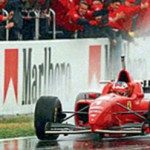Thank you…
- This topic has 10 replies, 8 voices, and was last updated 12 years, 10 months ago by
 Asanator.
Asanator.
- AuthorPosts
- 19th June 2011, 20:16 at 8:16 pm #129610
Anonymous
InactiveFirstly, thank you to everyone who has taken the time to contribute to the other thread I original contributed to, in response, I will take a glass of something red and french and settle in a corner for a while and pass the occasional comment or express a view. If anyone is interested, I much prefer a Cote du Rhone or Chateauneuf du Pape.
More importantly…
I’ve been reading and thinking about the RB diffuser solution again, just trying to understand how they have developed so much performance from it. Here is a view, not necessarily right but considered.
With a conventional aircraft wing the airflow is parted by the leading edge and air travelling over the top has to flow faster than the air underneath thus creating a pressure differential which causes the lift. As we all know the wings on racing cars are turned over, so the faster airflow and therefore the lower air pressure is on the underside of the wing, hence the wing creates downforce. What is critical to all of this is ensuring that the air streams join back together cleanly otherwise you are just creating turbulence and therefore drag.
This lift/downforce effect can also be achieved to a lesser extent by creating a temperature differential between upper and lower sides of the wing(s). The RB 2010 car changed mid season, there were subtle changes to the way exhaust was ported but as important was what was happenning with the radiator and oil cooler air. It seems that some of this ‘waste’ is blown out to an area under the main plane of the rear wing, thus reducing the pressure ever so slightly. It is important to note that this airflow does not seem to interfere with airflow over the lower wing section. Couple this with the hot blown diffuser where the exhaust gas is blown underside of the diffuser even when off-throttle you have a marked performance advantage.
What I think I’m saying is that Adrian Newey has found a solution that uses multiple solutions which work individually but don’t intefere with one another.
19th June 2011, 22:05 at 10:05 pm #171596Icthyes
ParticipantCotes du Rhone, I like you already!
Although the conventionally-taught aircraft wing theory is a little more complicated: http://warp.povusers.org/grrr/airfoilmyth.html
20th June 2011, 23:15 at 11:15 pm #171597Mads
Participant@SydOpera If you are talking about the cannon seized hole on the back of the RB7 i think you might be right. If the air under the rear wing is warmer, then it will be thinner and move quicker, which could make a pressure difference. Though Icthyes explanation shoots that down slightly.
Still i think there might be something to it. I mean in F1 it is all about the details and if it can give just one kilo of downforce, then that still means faster lap times and of all men in F1 i doubt Newey would let go on any chance to gain that tiny bit more downforce then the others.
Another reason i think is that they want to pack the rear of the car as tightly as they can, hence why they made their own battery pack for their KERS system, to channel more air over the diffuser to create more downforce.
@Icthyes Wow thanks! I have always been told the other explanation, and i just checked on NASA’s website and they agree with what is explained in your link.
It is always nice to learn something new, but on the same time it worries me slightly that the explanation of lift on an aerofoil that is consistently taught in the Danish schools is so massively simplified that it is actually wrong.
21st June 2011, 13:09 at 1:09 pm #171598 AsanatorParticipant
AsanatorParticipantYes it is a good explanation, however I would throw in there that it does not take into consideration an F1 cars proximity to the ground which enables the engineers to design elaborate floor shapes which can speed up the flow of air under the car making the low pressure zone larger. This cannot be done in flight.
21st June 2011, 13:35 at 1:35 pm #171599 Magnificent GeoffreyParticipant
Magnificent GeoffreyParticipantWhere do you guys learn all this stuff? As a life-long F1 fan, I still can’t get my head around the technical side of the sport very well at all.
21st June 2011, 16:06 at 4:06 pm #171600vinicius.jlantunes
ParticipantI second Magnificent Geoffrey.
21st June 2011, 16:26 at 4:26 pm #171601Anonymous
InactiveNeither can I!
21st June 2011, 17:14 at 5:14 pm #171602Icthyes
ParticipantActually Asanator, if I’ve understood the link correctly it describes exactly why making the air flow faster under the car produces downforce. The reason it doesn’t happen with aeroplanes is because the speed difference is too insignificant to cause the effect.
To simplify, it isn’t the difference in the speed of the air going under the wing versus over the wing, but the difference in speed of the air going over the wing versus the air which is closest to the top of the wing. That and the higher pressure acting on the underneath of the wing.
21st June 2011, 18:53 at 6:53 pm #171603AndrewTanner
Participant@Magffrey – I knew very little about the technical side of the sport but I have always had an interest in physics so a lot of this stuff makes sense to me. Think of airflow as water and how hot air rises etc etc…
Try the website howstuffworks.com (I think that’s it) and check out thermodynamics and fluid dynamics :)
21st June 2011, 20:45 at 8:45 pm #171604Icthyes
ParticipantI dunno, conceptual physics was always easy for me. Maths, however…
22nd June 2011, 12:01 at 12:01 pm #171605 AsanatorParticipant
AsanatorParticipantHi Icthyes,
Yes that is pretty much what I said isn’t it? your first paragraph? Which is why the Bernoulli effect is more relevant to an F1 car than an Aircraft. This is only relevant when talking about the airflow over the entire car rather than the individual wings where angle of attack has more effect.
Secondly, the diagrams partly explains why the diffusers on an F1 car are so important as they throw the air exiting the underneath of the car upwards which helps with the ‘overall air direction is changed’ part of the diagram.
- AuthorPosts
- You must be logged in to reply to this topic.



